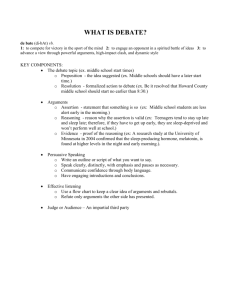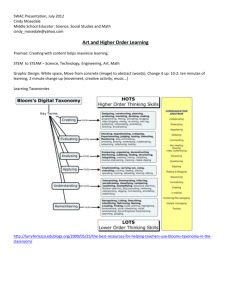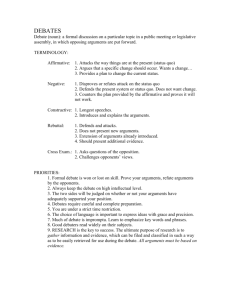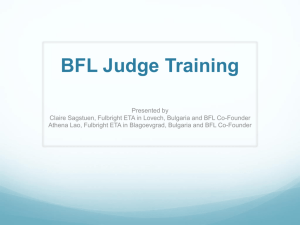Parli – Style Debate
advertisement
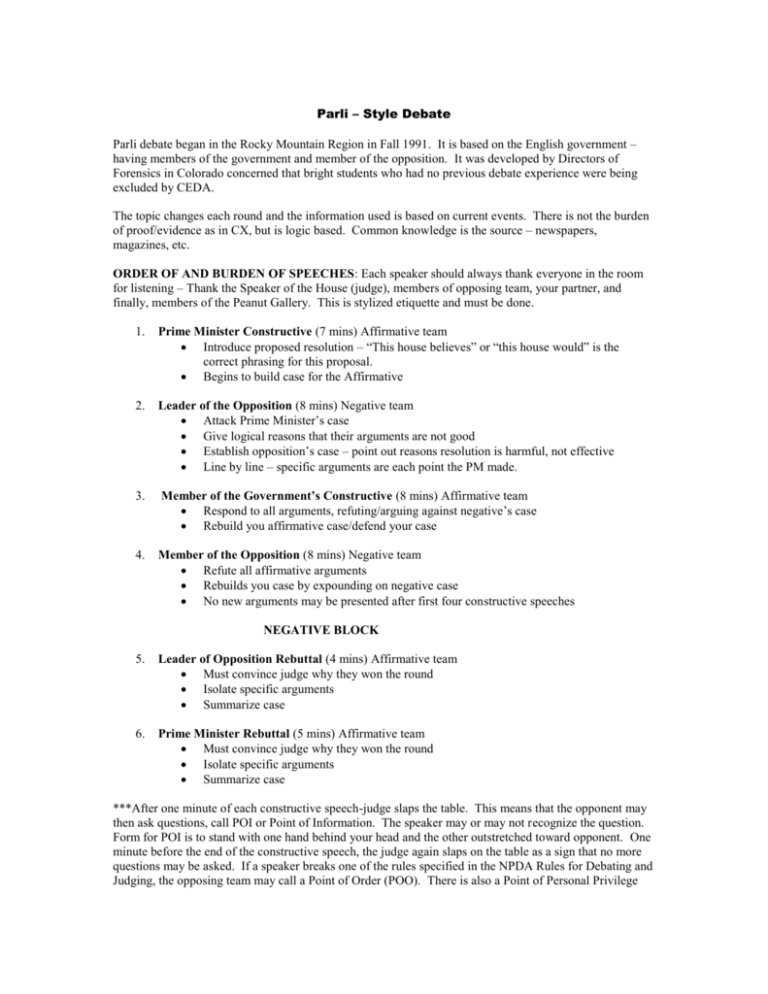
Parli – Style Debate Parli debate began in the Rocky Mountain Region in Fall 1991. It is based on the English government – having members of the government and member of the opposition. It was developed by Directors of Forensics in Colorado concerned that bright students who had no previous debate experience were being excluded by CEDA. The topic changes each round and the information used is based on current events. There is not the burden of proof/evidence as in CX, but is logic based. Common knowledge is the source – newspapers, magazines, etc. ORDER OF AND BURDEN OF SPEECHES: Each speaker should always thank everyone in the room for listening – Thank the Speaker of the House (judge), members of opposing team, your partner, and finally, members of the Peanut Gallery. This is stylized etiquette and must be done. 1. Prime Minister Constructive (7 mins) Affirmative team Introduce proposed resolution – “This house believes” or “this house would” is the correct phrasing for this proposal. Begins to build case for the Affirmative 2. Leader of the Opposition (8 mins) Negative team Attack Prime Minister’s case Give logical reasons that their arguments are not good Establish opposition’s case – point out reasons resolution is harmful, not effective Line by line – specific arguments are each point the PM made. 3. Member of the Government’s Constructive (8 mins) Affirmative team Respond to all arguments, refuting/arguing against negative’s case Rebuild you affirmative case/defend your case 4. Member of the Opposition (8 mins) Negative team Refute all affirmative arguments Rebuilds you case by expounding on negative case No new arguments may be presented after first four constructive speeches NEGATIVE BLOCK 5. Leader of Opposition Rebuttal (4 mins) Affirmative team Must convince judge why they won the round Isolate specific arguments Summarize case 6. Prime Minister Rebuttal (5 mins) Affirmative team Must convince judge why they won the round Isolate specific arguments Summarize case ***After one minute of each constructive speech-judge slaps the table. This means that the opponent may then ask questions, call POI or Point of Information. The speaker may or may not recognize the question. Form for POI is to stand with one hand behind your head and the other outstretched toward opponent. One minute before the end of the constructive speech, the judge again slaps on the table as a sign that no more questions may be asked. If a speaker breaks one of the rules specified in the NPDA Rules for Debating and Judging, the opposing team may call a Point of Order (POO). There is also a Point of Personal Privilege (POP). If a speaker is insulting or if they severely misconstrue their argument, the opposing team may call a POP to call this to the Speaker of the House’s attention. Value Worth of an object or idea Example: Freedom Liberty Freedom of speech Democracy Criterion Way to judge success of round CBA - cost benefit analysis (Does it save $, resources etc) RBA – risk benefit analysis (Does it lower risk) In a Nutshell 1. 2. 3. 4. 5. 6. 7. Provides opportunity for students to develop logic and reasoning skills. Develops extemporaneous speaking skills Provides case construction Provides for reinforcement of stock issues – significance, harms, inherency, topicality, and solvency – the S.H.I.T.S of debate Provides for opportunity to recognize two sides to every question Develops flowing abilities Provides opportunity to discuss current event issues Students engage in a classroom debate on a timely topic. They use general knowledge (little research) and little time (20 minutes preparation) to build and defend a case. Format is the case structure of the Government and Opposition’s arguments Example “This House believes that all secondary school students should wear uniforms.” Definitions….define any words in the resolution that maybe problematic Secondary – grades 7 to 12 Uniforms – standardized unit of dress Problem...Discuss and analyze the overall problem the resolution solves Academic Achievement (AA) in America is declining International test scores are higher than U.S. test scores This could lead to protectionism, losing our hegemony, isolation, nuke war. Solution/Plan...All U.S. 7-12 grade students will wear uniforms Advantages to our plan: 1. increase AA 2. reduce socio-economic discrimination with clothing 3. reduce classroom distractions 4. reduce gang involvement 5. reduce dress code violations Value…Education Criterian...Cost Benefit Analysis ($$$) Risk Benefit Analysis
